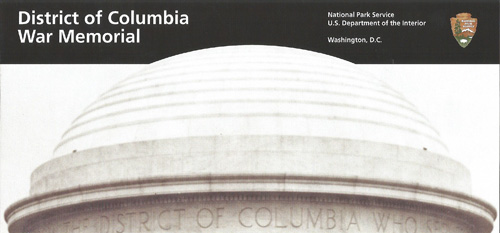|
District of Columbia War Memorial National Mall and Memorial Parks District of Columbia |
 |
 NPS photo | |
THE NAMES OF THE MEN AND WOMEN FROM THE DISTRICT OF COLUMBIA WHO GAVE THEIR LIVES IN THE WORLD WAR ARE HERE INSCRIBED AS A PERPETUAL RECORD OF THEIR PATRIOTIC SERVICE TO THEIR COUNTRY • THOSE WHO FELL AND THOSE WHO SURVIVED HAVE GIVEN TO THIS AND TO FUTURE GENERATIONS AN EXAMPLE OF HIGH IDEALISM COURAGEOUS SACRIFICE AND GALLANT ACHIEVEMENT
—Memorial Inscription
"Since I do not have even the grave of my boy, a memorial which will represent him here will, of course, be very sacred to me."
—MRS. GRACE D. SEIBOLD
President, District of Columbia Chapter of American War Mothers.Mrs. Seibold lost her son, 1st Lieutenant George Seibold in the war. His name appears on the memorial.
The World at War
A Serbian nationalist assassinated Archduke Franz Ferdinand, the heir to the Austro-Hungarian Empire on June 28, 1914 and triggered the devasting system of national alliances that resulted in over 37 million casualties, including 9 million dead. The world war culminated with the dissolution of four great empires and the creation or re-creation of more than a dozen countries in Europe and the Middle East.
World War I marked the first time in American history that the United States sent soldiers abroad to defend foreign soil. When the U.S. entered the war on April 6, 1917, it had a standing army of about 127,500 soldiers. By the time the fighting ended 19 months later, on November 11, 1918, the American Expeditionary Force had grown to over four million men. The U.S. calculated its forces had sufFered an estimated 365,000 casualties: 234,300 wounded and 126,000 dead. Hundreds more were missing and more than 4,000 U.S. military men were captured.
26,000 men and women from the District of Columbia served their country in the Great War and 492 of Washington's sons and seven of its daughters gave their lives in that service.
Honoring the Dead
The war had been over for less than a month when letters in support of erecting local memorials to veterans and fallen soldiers began pouring in to the U.S. Commission of Fine Arts.
Frank B. Noyes, the president of the Associated Press and the Washington Evening Star, and his wife, Janet T. Noyes, who was active in many civic organizations, spearheaded the effort to erect a memorial to the residents of D.C. who served in the war.
On April 8, 1920, a joint resolution was introduced in the House of Representatives appointing a commission for the purpose of erecting in Potomac Park, a memorial to those members of the Armed Forces of the United States from the District of Columbia who served in the war. Congress passed a final resolution on June 7, 1924.
The Memorial
Architect Frederick H. Brooke first submitted plans to the memorial commission in 1919. Once the building was to become a reality with the passage of Resolution 28 in 1924, Brooke informed the memorial commission that Nathan C. Wyeth and Horace W Peaslee had agreed to act as his associates in preparing the plans. All three were veterans of the war.
A circular, open-air, Doric structure built almost entirely of Vermont marble, the memorial has an overall height of 47 feet and a diameter of 44 feet, large enough to accommodate the entire U.S. Marine Band. It was intended that the structure be a memorial and a bandstand and that each concert would be a tribute to those who served and sacrificed in the war.
The memorial stands on a four-foot-high circular marble platform around which are inscribed the names of the 499 Washington residents who died in service during World War I.
The names were inscribed on the face of the platform in alphabetical order with no distinction made to rank, race, or gender. The D.C. War Memorial is the only District memorial on the National Mall. It symbolizes the unique distinction of Washington, D.C. as a local entity even though it is the federal capital.
Construction was completed in 1931 and the memorial was dedicated by President Herbert Hoover on the national observance of Armistice Day, November 11, 1931, "13 years, to the day and to the hour, the armistice took effect." World War I veterans, Gold Star Mothers, the American Legion, the Veterans of Foreign Wars, and the Disabled American Veterans made up some of the thousands in attendance for the dedication. Thousands more across the country listened to the live radio coverage. Other notable attendees were General John J. Pershing and John Philip Sousa, a native Washingtonian and the former conductor of the U.S. Marine Band.
About Your Visit
Park information may be found nearby at the World War II Memorial, the Korean War Veterans Memorial, the Franklin Delano Roosevelt Memorial, and the Martin Luther King, Jr. Memorial. Park rangers are present in the park each day except December 25. The memorial may be secured for events celebrating National Independence Day. The nearby Franklin Delano Roosevelt Memorial bookstore sells informational items about the First World War and the American experience.
Source: NPS Brochure (undated)
Brochures

Documents
Cultural Landscapes Inventory: DC War Memorial, National Mall & Memorial Parks - West Potomac Park (2009)
Historic Structure Report & Cultural Landscape Assessment: District of Columbia War Memorial (John G. Waite Associates, May 2006)
Handbooks & Books

nama/places/dcwm.htm
Last Updated: 01-Aug-2024
